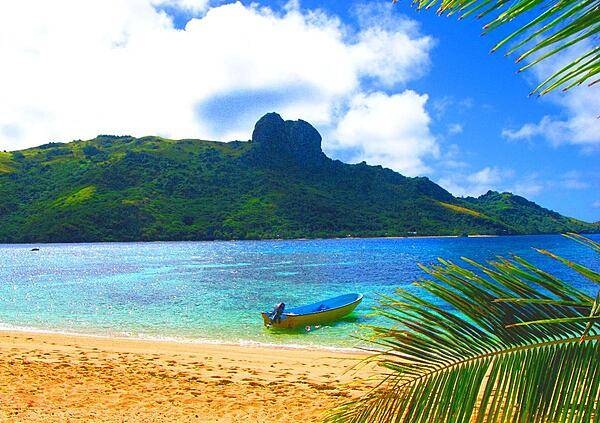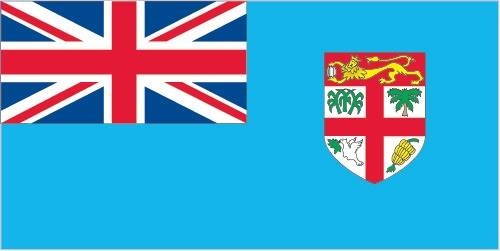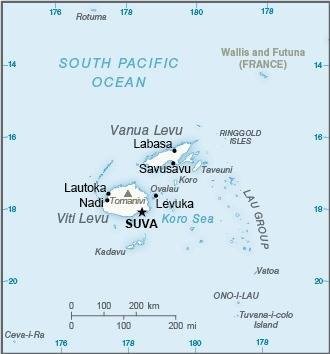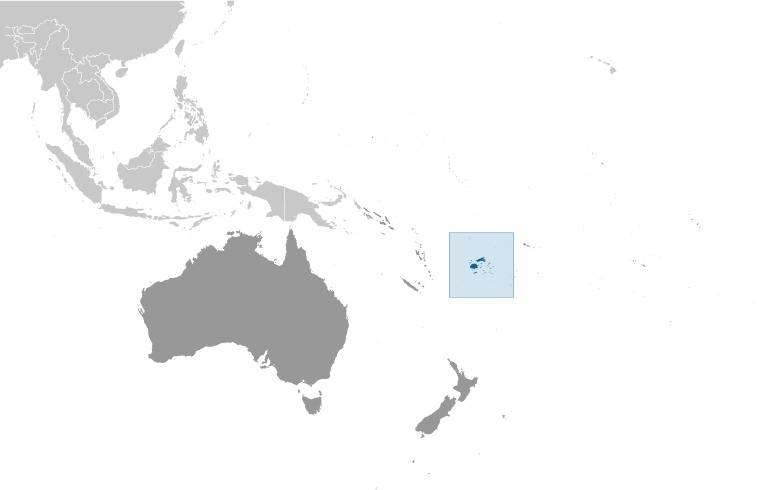Introduction
Background
Austronesians settled Fiji around 1000 B.C., followed by successive waves of Melanesians starting around the first century A.D. Fijians traded with Polynesian groups in Samoa and Tonga, and by about 900, much of Fiji was in the Tu’i Tongan Empire’s sphere of influence. The Tongan influence declined significantly by 1200, while Melanesian seafarers continued to periodically arrive in Fiji, further mixing Melanesian and Polynesian cultural traditions. Dutch explorer Abel TASMAN was the first European to spot Fiji in 1643, followed by British explorer James COOK in 1774. Captain William BLIGH plotted the islands in 1789. In the 1800s, merchants, traders, and whalers frequented the islands and the first missionaries arrived in 1835. Rival kings and chiefs competed for power, at times aided by Europeans and their weapons, and in 1865, Seru Epenisa CAKOBAU united many groups into the Confederacy of Independent Kingdoms of Viti. The arrangement proved weak and in 1871 CAKOBAU formed the Kingdom of Fiji in an attempt to centralize power. Fearing a hostile takeover by a foreign power as the kingdom’s economy began to falter, CAKOBAU ceded Fiji to the UK in 1874.
The first British governor set up a plantation-style economy and brought in more than 60,000 Indians as indentured laborers, most of whom chose to stay in Fiji rather than return to India when their contracts expired. In the early 1900s, society was divided along ethnic lines, with iTaukei (indigenous Fijians), Europeans, and Indo-Fijians living in separate areas and maintaining their own languages and traditions. ITaukei fears of an Indo-Fijian takeover of government delayed independence through the 1960s; Fiji achieved independence in 1970 with agreements in place to allocate parliamentary seats by ethnic groups. Long-serving Prime Minister Kamisese MARA largely balanced these ethnic divisions, but concerns about growing Indo-Fijian political influence led to two coups in 1987. A new constitution in 1990 cemented iTaukei control of politics, leading thousands of Indo-Fijians to leave. A reformed constitution in 1997 was more equitable and led to the election of an Indo-Fijian prime minister in 1999, who was ousted in a coup the following year. In 2005, the new prime minister put forward a bill that would grant pardons to the coup perpetrators, leading Commodore Josaia BAINIMARAMA to launch a coup in 2006. BAINIMARAMA appointed himself prime minister in 2007 and continues to hold the position after elections in 2014 and 2018 that international observers deemed credible.
With well-developed infrastructure, Fiji has become a hub for the Pacific, hosting the secretariat for the Pacific Islands Forum and the main campus of the University of the South Pacific. In addition, Fiji is a center for Pacific tourism, and Nadi International Airport is by far the busiest airport in a Pacific island country.
Visit the Definitions and Notes page to view a description of each topic.
Geography
Location
Oceania, island group in the South Pacific Ocean, about two-thirds of the way from Hawaii to New Zealand
Geographic coordinates
18 00 S, 175 00 E
Map references
Oceania
Area - comparative
slightly smaller than New Jersey
Land boundaries
total: 0 km
Coastline
1,129 km
Maritime claims
territorial sea: 12 nm
contiguous zone: 24 nm
exclusive economic zone: 200 nm
continental shelf: 200-m depth or to the depth of exploitation
measured from claimed archipelagic straight baselines
Climate
tropical marine; only slight seasonal temperature variation
Terrain
mostly mountains of volcanic origin
Elevation
highest point: Tomanivi 1,324 m
lowest point: Pacific Ocean 0 m
Natural resources
timber, fish, gold, copper, offshore oil potential, hydropower
Land use
agricultural land: 23.3% (2018 est.)
arable land: 9% (2018 est.)
permanent crops: 4.7% (2018 est.)
permanent pasture: 9.6% (2018 est.)
forest: 55.7% (2018 est.)
other: 21% (2018 est.)
Irrigated land
40 sq km (2012)
Population distribution
approximately 70% of the population lives on the island of Viti Levu; roughly half of the population lives in urban areas
Natural hazards
cyclonic storms can occur from November to January
Geography - note
consists of 332 islands, approximately 110 of which are inhabited, and more than 500 islets
People and Society
Nationality
noun: Fijian(s)
adjective: Fijian
Ethnic groups
iTaukei 56.8% (predominantly Melanesian with a Polynesian admixture), Indo-Fijian 37.5%, Rotuman 1.2%, other 4.5% (European, part European, other Pacific Islanders, Chinese) (2007 est.)
note: a 2010 law replaces 'Fijian' with 'iTaukei' when referring to the original and native settlers of Fiji
Languages
English (official), iTaukei (official), Fiji Hindi (official)
Religions
Protestant 45% (Methodist 34.6%, Assembly of God 5.7%, Seventh Day Adventist 3.9%, and Anglican 0.8%), Hindu 27.9%, other Christian 10.4%, Roman Catholic 9.1%, Muslim 6.3%, Sikh 0.3%, other 0.3%, none 0.8% (2007 est.)
Age structure
0-14 years: 26.86% (male 128,499/female 122,873)
15-24 years: 15.51% (male 73,993/female 71,139)
25-54 years: 41.05% (male 196,932/female 187,270)
55-64 years: 9.25% (male 43,813/female 42,763)
65 years and over: 7.34% (male 31,556/female 37,136) (2020 est.)
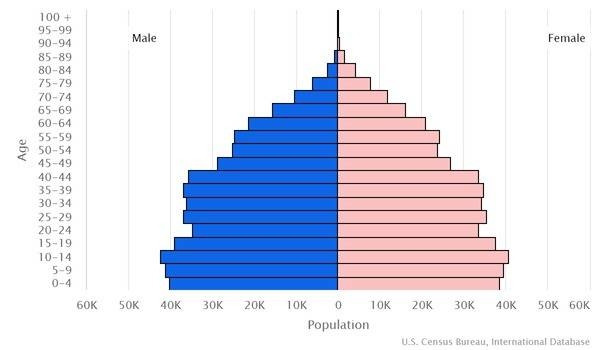
Dependency ratios
total dependency ratio: 53
youth dependency ratio: 44.2
elderly dependency ratio: 8.7
potential support ratio: 11.4 (2021 est.)
Median age
total: 29.9 years
male: 29.7 years
female: 30.1 years (2020 est.)
Population distribution
approximately 70% of the population lives on the island of Viti Levu; roughly half of the population lives in urban areas
Urbanization
urban population: 58.7% of total population (2023)
rate of urbanization: 1.37% annual rate of change (2020-25 est.)
Major urban areas - population
178,000 SUVA (capital) (2018)
Sex ratio
at birth: 1.05 male(s)/female
0-14 years: 1.04 male(s)/female
15-24 years: 1.04 male(s)/female
25-54 years: 1.06 male(s)/female
55-64 years: 1.02 male(s)/female
65 years and over: 0.6 male(s)/female
total population: 1.03 male(s)/female (2022 est.)
Maternal mortality ratio
34 deaths/100,000 live births (2017 est.)
country comparison to the world: 107Infant mortality rate
total: 10.06 deaths/1,000 live births
male: 11.59 deaths/1,000 live births
female: 8.45 deaths/1,000 live births (2022 est.)
Life expectancy at birth
total population: 74.27 years
male: 71.6 years
female: 77.07 years (2022 est.)
Contraceptive prevalence rate
35.5% (2021)
Drinking water source
improved: urban: 98.2% of population
rural: 89.1% of population
total: 94.3% of population
unimproved: urban: 1.8% of population
rural: 10.9% of population
total: 5.7% of population (2020 est.)
Current health expenditure
3.8% of GDP (2019)
Physicians density
0.86 physicians/1,000 population (2015)
Hospital bed density
2 beds/1,000 population (2016)
Sanitation facility access
improved: urban: 100% of population
rural: 100% of population
total: 100% of population
unimproved: urban: 0% of population
rural: 0% of population
total: 0% of population (2020 est.)
Major infectious diseases
degree of risk: high (2020)
food or waterborne diseases: bacterial diarrhea
vectorborne diseases: malaria
Alcohol consumption per capita
total: 2.71 liters of pure alcohol (2019 est.)
beer: 1.64 liters of pure alcohol (2019 est.)
wine: 0.29 liters of pure alcohol (2019 est.)
spirits: 0.79 liters of pure alcohol (2019 est.)
other alcohols: 0 liters of pure alcohol (2019 est.)
Tobacco use
total: 23.1% (2020 est.)
male: 35.6% (2020 est.)
female: 10.5% (2020 est.)
Literacy
total population: 99.1%
male: 99.1%
female: 99.1% (2018)
Youth unemployment rate (ages 15-24)
total: 15.4%
male: 11.9%
female: 22.4% (2016 est.)
Environment
Environment - current issues
the widespread practice of waste incineration is a major contributor to air pollution in the country, as are vehicle emissions in urban areas; deforestation and soil erosion are significant problems; a contributory factor to erosion is clearing of land by bush burning, a widespread practice that threatens biodiversity
Environment - international agreements
party to: Biodiversity, Climate Change, Climate Change-Kyoto Protocol, Climate Change-Paris Agreement, Comprehensive Nuclear Test Ban, Desertification, Endangered Species, Law of the Sea, Marine Life Conservation, Nuclear Test Ban, Ozone Layer Protection, Ship Pollution, Tropical Timber 2006, Wetlands
signed, but not ratified: none of the selected agreements
Air pollutants
particulate matter emissions: 10.19 micrograms per cubic meter (2016 est.)
carbon dioxide emissions: 2.05 megatons (2016 est.)
methane emissions: 0.95 megatons (2020 est.)
Climate
tropical marine; only slight seasonal temperature variation
Land use
agricultural land: 23.3% (2018 est.)
arable land: 9% (2018 est.)
permanent crops: 4.7% (2018 est.)
permanent pasture: 9.6% (2018 est.)
forest: 55.7% (2018 est.)
other: 21% (2018 est.)
Urbanization
urban population: 58.7% of total population (2023)
rate of urbanization: 1.37% annual rate of change (2020-25 est.)
Revenue from forest resources
forest revenues: 0.59% of GDP (2018 est.)
country comparison to the world: 63Major infectious diseases
degree of risk: high (2020)
food or waterborne diseases: bacterial diarrhea
vectorborne diseases: malaria
Waste and recycling
municipal solid waste generated annually: 189,390 tons (2011 est.)
municipal solid waste recycled annually: 10,322 tons (2013 est.)
percent of municipal solid waste recycled: 5.5% (2013 est.)
Total water withdrawal
municipal: 25.3 million cubic meters (2017 est.)
industrial: 9.6 million cubic meters (2017 est.)
agricultural: 50 million cubic meters (2017 est.)
Total renewable water resources
28.55 billion cubic meters (2017 est.)
Government
Country name
conventional long form: Republic of Fiji
conventional short form: Fiji
local long form: Republic of Fiji (English)/ Matanitu ko Viti (Fijian)
local short form: Fiji (English)/ Viti (Fijian)
etymology: the Fijians called their home Viti, but the neighboring Tongans called it Fisi, and in the Anglicized spelling of the Tongan pronunciation - promulgated by explorer Captain James COOK - the designation became Fiji
Government type
parliamentary republic
Capital
name: Suva (on Viti Levu)
geographic coordinates: 18 08 S, 178 25 E
time difference: UTC+12 (17 hours ahead of Washington, DC, during Standard Time)
etymology: the name means "little hill" in the native Fijian (iTaukei) language and refers to a mound where a temple once stood
Administrative divisions
14 provinces and 1 dependency*; Ba, Bua, Cakaudrove, Kadavu, Lau, Lomaiviti, Macuata, Nadroga and Navosa, Naitasiri, Namosi, Ra, Rewa, Rotuma*, Serua, Tailevu
Independence
10 October 1970 (from the UK)
National holiday
Fiji (Independence) Day, 10 October (1970)
Constitution
history: several previous; latest signed into law 6 September 2013
amendments: proposed as a bill by Parliament and supported by at least three quarters of its members, followed by referral to the president and then to the Electoral Commission, which conducts a referendum; passage requires approval by at least three-quarters of registered voters and assent by the president
Legal system
common law system based on the English model
International law organization participation
has not submitted an ICJ jurisdiction declaration; accepts ICCt jurisdiction
Citizenship
citizenship by birth: no
citizenship by descent only: at least one parent must be a citizen of Fiji
dual citizenship recognized: yes
residency requirement for naturalization: at least 5 years residency out of the 10 years preceding application
Suffrage
18 years of age; universal
Executive branch
chief of state: President Ratu Wiliame KATONIVERE (since 12 November 2021)
head of government: Prime Minister Voreqe "Frank" BAINIMARAMA (since 22 September 2014)
cabinet: Cabinet appointed by the prime minister from among members of Parliament and is responsible to Parliament
elections/appointments: president elected by Parliament for a 3-year term (eligible for a second term); election last held on 22 October 2021 (next to be held in 2024); prime minister endorsed by the president
election results: Ratu Wiliame KATONIVERE elected president with 28 votes against 23 votes for Teimumu KEPA
Legislative branch
description: unicameral Parliament (51 seats; members directly elected in a nationwide, multi-seat constituency by open-list proportional representation vote to serve 4-year terms)
elections: last held on 14 November 2018 (next to be held in 2022)
election results: percent of vote by party - FijiFirst 50%, SODELPA 39.6%, NFP 7.4%; seats by party - FijiFirst 27, SODELPA 21, NFP 3; composition - men 41, women 10, percent of women 19.6%
Judicial branch
highest court(s): Supreme Court (consists of the chief justice, all justices of the Court of Appeal, and judges appointed specifically as Supreme Court judges); Court of Appeal (consists of the court president, all puisne judges of the High Court, and judges specifically appointed to the Court of Appeal); High Court (chaired by the chief justice and includes a minimum of 10 puisne judges; High Court organized into civil, criminal, family, employment, and tax divisions)
judge selection and term of office: chief justice appointed by the president of Fiji on the advice of the prime minister following consultation with the parliamentary leader of the opposition; judges of the Supreme Court, the president of the Court of Appeal, the justices of the Court of Appeal, and puisne judges of the High Court appointed by the president of Fiji upon the nomination of the Judicial Service Commission after consulting with the cabinet minister and the committee of the House of Representatives responsible for the administration of justice; the chief justice, Supreme Court judges and justices of Appeal generally required to retire at age 70, but this requirement may be waived for one or more sessions of the court; puisne judges appointed for not less than 4 years nor more than 7 years, with mandatory retirement at age 65
subordinate courts: Magistrates' Court (organized into civil, criminal, juvenile, and small claims divisions)
Political parties and leaders
FijiFirst [Veroqe "Frank" BAINIMARAMA]
Fiji Labor Party or FLP [Mahendra CHAUDHRY]
Freedom Alliance [Jagath KARUNARATNE] (formerly Fiji United Freedom Party or FUFP)
National Federation Party or NFP [Biman PRASAD] (primarily Indian)
Peoples Democratic Party or PDP [Lynda TABUYA]
Social Democratic Liberal Party or SODELPA [Viliame Rogoibulu GAVOKA]
Unity Fiji [Savenaca NARUBE]
International organization participation
ACP, ADB, AOSIS, C, CP, FAO, G-77, IAEA, IBRD, ICAO, ICCt, ICRM, IDA, IFAD, IFC, IFRCS, IHO, ILO, IMF, IMO, Interpol, IOC, IOM, ISO, ITSO, ITU, ITUC (NGOs), MIGA, OPCW, PCA, PIF, Sparteca (suspended), SPC, UN, UNCTAD, UNDOF, UNESCO, UNIDO, UNISFA, UNMISS, UNWTO, UPU, WCO, WFTU (NGOs), WHO, WIPO, WMO, WTO
Diplomatic representation in the US
chief of mission: Ambassador (vacant); Charge d'Affaires Akuila VUIRA
chancery: 1707 L Street NW, Suite 200, Washington, DC 20036
telephone: [1] (202) 466-8320
FAX: [1] (202) 466-8325
email address and website:
info@FijiEmbassyDC.com
https://www.fijiembassydc.com/
Diplomatic representation from the US
chief of mission: Ambassador (vacant); Charge d'Affaires Tony GREUBEL (since 20 January 2021); note - also accredited to Kiribati, Nauru, Tonga, and Tuvalu
embassy: 158 Princes Road, Tamavua, Suva
mailing address: 4290 Suva Place, Washington DC 20521-4290
telephone: [679] 331-4466
FAX: [679] 330-2267
email address and website:
SuvaACS@state.gov
https://fj.usembassy.gov/
Flag description
light blue with the flag of the UK in the upper hoist-side quadrant and the Fijian shield centered on the outer half of the flag; the blue symbolizes the Pacific Ocean and the Union Jack reflects the links with Great Britain; the shield - taken from Fiji's coat of arms - depicts a yellow lion, holding a coconut pod between its paws, above a white field quartered by the cross of Saint George; the four quarters depict stalks of sugarcane, a palm tree, a banana bunch, and a white dove of peace
National symbol(s)
Fijian canoe; national color: light blue
National anthem
name: "God Bless Fiji"
lyrics/music: Michael Francis Alexander PRESCOTT/C. Austin MILES (adapted by Michael Francis Alexander PRESCOTT)
note: adopted 1970; known in Fijian as "Meda Dau Doka" (Let Us Show Pride); adapted from the hymn, "Dwelling in Beulah Land," the anthem's English lyrics are generally sung, although they differ in meaning from the official Fijian lyrics
National heritage
total World Heritage Sites: 1 (cultural)
selected World Heritage Site locales: Levuka Historical Port Town
Economy
Economic overview
Fiji, endowed with forest, mineral, and fish resources, is one of the most developed and connected of the Pacific island economies. Earnings from the tourism industry, with an estimated 842,884 tourists visiting in 2017, and remittances from Fijian’s working abroad are the country’s largest foreign exchange earners.
Bottled water exports to the US is Fiji’s largest domestic export. Fiji's sugar sector remains a significant industry and a major export, but crops and one of the sugar mills suffered damage during Cyclone Winston in 2016. Fiji’s trade imbalance continues to widen with increased imports and sluggish performance of domestic exports.
The return to parliamentary democracy and successful elections in September 2014 improved investor confidence, but increasing bureaucratic regulation, new taxes, and lack of consultation with relevant stakeholders brought four consecutive years of decline for Fiji on the World Bank Ease of Doing Business index. Private sector investment in 2017 approached 20% of GDP, compared to 13% in 2013.
Real GDP (purchasing power parity)
$9.86 billion (2020 est.)
$12.18 billion (2019 est.)
$12.23 billion (2018 est.)
note: data are in 2017 dollars
Real GDP growth rate
3% (2017 est.)
0.7% (2016 est.)
3.8% (2015 est.)
Real GDP per capita
$11,000 (2020 est.)
$13,700 (2019 est.)
$13,800 (2018 est.)
note: data are in 2017 dollars
GDP (official exchange rate)
$4.891 billion (2017 est.)
Inflation rate (consumer prices)
3.4% (2017 est.)
3.9% (2016 est.)
Credit ratings
Moody's rating: Ba3 (2017)
Standard & Poors rating: BB- (2019)
note: The year refers to the year in which the current credit rating was first obtained.
GDP - composition, by sector of origin
agriculture: 13.5% (2017 est.)
industry: 17.4% (2017 est.)
services: 69.1% (2017 est.)
GDP - composition, by end use
household consumption: 81.3% (2017 est.)
government consumption: 24.4% (2017 est.)
investment in fixed capital: 16.9% (2017 est.)
investment in inventories: 0% (2017 est.)
exports of goods and services: 29% (2017 est.)
imports of goods and services: -51.6% (2017 est.)
Agricultural products
sugar cane, cassava, taro, poultry, vegetables, coconuts, eggs, milk, ginger, sweet potatoes
Industries
tourism, sugar processing, clothing, copra, gold, silver, lumber
Labor force - by occupation
agriculture: 44.2%
industry: 14.3%
services: 41.6% (2011)
Youth unemployment rate (ages 15-24)
total: 15.4%
male: 11.9%
female: 22.4% (2016 est.)
Population below poverty line
29.9% (2019 est.)
Gini Index coefficient - distribution of family income
36.7 (2013 est.)
country comparison to the world: 87Household income or consumption by percentage share
lowest 10%: 2.6%
highest 10%: 34.9% (2009 est.)
Budget
revenues: 1.454 billion (2017 est.)
expenditures: 1.648 billion (2017 est.)
Fiscal year
calendar year
Current account balance
-$277 million (2017 est.)
-$131 million (2016 est.)
Exports
$1.23 billion (2020 est.) note: data are in current year dollars
$2.64 billion (2019 est.) note: data are in current year dollars
$2.67 billion (2018 est.) note: data are in current year dollars
Exports - partners
United States 29%, Australia 14%, New Zealand 7%, Japan 6%, Tonga 6% (2019)
Exports - commodities
water, refined petroleum, fish, raw sugar, gold (2019)
Imports
$1.97 billion (2020 est.) note: data are in current year dollars
$3.21 billion (2019 est.) note: data are in current year dollars
$3.1 billion (2018 est.) note: data are in current year dollars
Imports - partners
Singapore 18%, Australia 13%, China 13.8%, New Zealand 11%, France 11%, South Korea 8% (2017)
Imports - commodities
refined petroleum, aircraft, cars, wheat, broadcasting equipment (2019)
Reserves of foreign exchange and gold
$1.116 billion (31 December 2017 est.)
$908.6 million (31 December 2016 est.)
Debt - external
$1.022 billion (31 December 2017 est.)
$696.4 million (31 December 2016 est.)
Exchange rates
Fijian dollars (FJD) per US dollar -
2.05955 (2020 est.)
2.17345 (2019 est.)
2.1104 (2018 est.)
2.0976 (2014 est.)
1.8874 (2013 est.)
Energy
Electricity access
electrification - total population: 99.6% (2018)
electrification - urban areas: 100% (2018)
electrification - rural areas: 99.2% (2018)
Electricity
installed generating capacity: 393,000 kW (2020 est.)
consumption: 1,022,955,000 kWh (2019 est.)
exports: 0 kWh (2020 est.)
imports: 0 kWh (2020 est.)
transmission/distribution losses: 90 million kWh (2019 est.)
Electricity generation sources
fossil fuels: 41.9% of total installed capacity (2020 est.)
nuclear: 0% of total installed capacity (2020 est.)
solar: 1.6% of total installed capacity (2020 est.)
wind: 0.3% of total installed capacity (2020 est.)
hydroelectricity: 50.2% of total installed capacity (2020 est.)
tide and wave: 0% of total installed capacity (2020 est.)
geothermal: 0% of total installed capacity (2020 est.)
biomass and waste: 6% of total installed capacity (2020 est.)
Coal
production: 0 metric tons (2020 est.)
consumption: 0 metric tons (2020 est.)
exports: 0 metric tons (2020 est.)
imports: 0 metric tons (2020 est.)
proven reserves: 0 metric tons (2019 est.)
Petroleum
total petroleum production: 0 bbl/day (2021 est.)
refined petroleum consumption: 11,500 bbl/day (2019 est.)
crude oil and lease condensate exports: 0 bbl/day (2018 est.)
crude oil and lease condensate imports: 0 bbl/day (2018 est.)
crude oil estimated reserves: 0 barrels (2021 est.)
Natural gas
production: 0 cubic meters (2021 est.)
consumption: 0 cubic meters (2021 est.)
exports: 0 cubic meters (2021 est.)
imports: 0 cubic meters (2021 est.)
proven reserves: 0 cubic meters (2021 est.)
Carbon dioxide emissions
1.691 million metric tonnes of CO2 (2019 est.)
from coal and metallurgical coke: 0 metric tonnes of CO2 (2019 est.)
from petroleum and other liquids: 1.691 million metric tonnes of CO2 (2019 est.)
from consumed natural gas: 0 metric tonnes of CO2 (2019 est.)
Energy consumption per capita
32.901 million Btu/person (2019 est.)
country comparison to the world: 118Communications
Telephones - fixed lines
total subscriptions: 48,510 (2020 est.)
subscriptions per 100 inhabitants: 5 (2020 est.)
Telephones - mobile cellular
total subscriptions: 991,500 (2020 est.)
subscriptions per 100 inhabitants: 111 (2020 est.)
Telecommunication systems
general assessment: Fiji is the leading market to watch in terms of both LTE and 5G development in the region; the market boasts relatively sophisticated, advanced digital infrastructure, with telcos’ heavy investment resulting in the country having the highest mobile and internet subscriptions in the Pacific Islands region; LTE, LTE-A, and fiber technologies have received the most investment by the Fijian mobile operators, LTE now accounts for the largest share of connections in the mobile segment; concentrating on the more highly populated areas, the operators are preparing for the next growth area of high-speed data; they also have 5G in mind, and are preparing their networks to be 5G-ready, anticipating an easier migration to the technology based on the relatively high LTE subscription rate; Fiji presents a challenging geographic environment for infrastructure development due to its population being spread across more than 100 islands; the majority of Fijians live on the two main islands of Viti Levu and Vanua Levu; in July 2018, the two islands were linked by the Savusavu submarine cable system, which provides a more secure link in times of emergency weather events such as the regular tropical cyclones that often cause massive destruction to the area, including destroying essential infrastructure such as electricity and telecommunications equipment; notably, the December 2021 eruption of the Hunga Tonga–Hunga Ha'apai submarine volcano in Tonga damaged the Tonga Cable which connects Fiji, and Tonga blocking the latter off from internet services; cable theft and damage of critical communications infrastructure has also become a concern in Fiji, prompting authorities to establish a joint task force to tackle the issue (2022)
domestic: fixed-line nearly 5 per 100 persons and mobile-cellular teledensity roughly 111 per 100 persons (2020)
international: country code - 679; landing points for the ICN1, SCCN, Southern Cross NEXT, Tonga Cable and Tui-Samoa submarine cable links to US, NZ, Australia and Pacific islands of Fiji, Vanuatu, Kiribati, Samoa, Tokelau, Tonga, Fallis & Futuna, and American Samoa; satellite earth stations - 2 Inmarsat (Pacific Ocean) (2019)
note: the COVID-19 pandemic continues to have a significant impact on production and supply chains globally; since 2020, some aspects of the telecom sector have experienced a downturn, particularly in mobile device production; progress toward 5G implementation has resumed, as well as upgrades to infrastructure; consumer spending on telecom services has increased due to the surge in demand for capacity and bandwidth; the crucial nature of telecom services as a tool for work and school from home is still evident, and the spike in this area has seen growth opportunities for development of new tools and increased services
Broadcast media
Fiji TV, a publicly traded company, operates a free-to-air channel; Digicel Fiji operates the Sky Fiji and Sky Pacific multi-channel pay-TV services; state-owned commercial company, Fiji Broadcasting Corporation, Ltd, operates 6 radio stations - 2 public broadcasters and 4 commercial broadcasters with multiple repeaters; 5 radio stations with repeaters operated by Communications Fiji, Ltd; transmissions of multiple international broadcasters are available
Internet users
total: 444,978 (2019 est.)
percent of population: 50% (2019 est.)
Broadband - fixed subscriptions
total: 23,062 (2020 est.)
subscriptions per 100 inhabitants: 3 (2020 est.)
Transportation
National air transport system
number of registered air carriers: 2 (2020)
inventory of registered aircraft operated by air carriers: 16
annual passenger traffic on registered air carriers: 1,670,216 (2018)
annual freight traffic on registered air carriers: 106.83 million (2018) mt-km
Airports - with paved runways
total: 4
over 3,047 m: 1
1,524 to 2,437 m: 1
914 to 1,523 m: 2 (2021)
Airports - with unpaved runways
total: 24
914 to 1,523 m: 5
under 914 m: 19 (2021)
Railways
total: 597 km (2008)
narrow gauge: 597 km (2008) 0.600-m gauge
note: belongs to the government-owned Fiji Sugar Corporation; used to haul sugarcane during the harvest season, which runs from May to December
Roadways
total: 3,440 km (2011)
paved: 1,686 km (2011)
unpaved: 1,754 km (2011)
Waterways
203 km (2012) (122 km are navigable by motorized craft and 200-metric-ton barges)
country comparison to the world: 107Merchant marine
total: 73
by type: general cargo 20, oil tanker 4, other 49 (2021)
Ports and terminals
major seaport(s): Lautoka, Levuka, Suva
Military and Security
Military and security forces
Republic of Fiji Military Force (RFMF): Land Force Command, Maritime Command; Fiji Police Force (2022)
note: the RFMF is subordinate to the president as the commander-in-chief, while the Fiji Police Force reports to the the Ministry of Defense, National Security, and Policing
Military expenditures
1.5% of GDP (2021 est.)
1.4% of GDP (2020 est.)
1.6% of GDP (2019 est.) (approximately $160 million)
1.6% of GDP (2018 est.) (approximately $160 million)
1.5% of GDP (2017 est.) (approximately $150 million)
Military and security service personnel strengths
approximately 4,000 active personnel (2022)
Military equipment inventories and acquisitions
the RFMF is lightly armed and equipped; Australia has provided patrol boats and a few armored personnel carriers; it also provides logistical support for RFMF regional or UN operations; in recent years, China has provided construction equipment and military vehicles (2021)
Military service age and obligation
18-25 years of age for voluntary military service; mandatory retirement at age 55 (2022)
Military deployments
170 Egypt (MFO); 165 Iraq (UNAMI); 150 Golan Heights (UNDOF) (2022)
Military - note
the RFMF was established in 1920; it has a history of intervening in the country’s politics since the late 1980s, including coups in 1987 and 2006, and a mutiny in 2000
the RFMF also has a long tradition of participating in UN peacekeeping operations; since its first deployment of troops to South Lebanon in 1978 under the United Nations Interim Force in Lebanon (UNIFIL), it has deployed troops on nearly 20 additional UN missions
Fiji has a "shiprider" agreement with the US, which allows local maritime law enforcement officers to embark on US Coast Guard (USCG) and US Navy (USN) vessels, including to board and search vessels suspected of violating laws or regulations within Fiji's designated exclusive economic zone (EEZ) or on the high seas; "shiprider" agreements also enable USCG personnel and USN vessels with embarked USCG law enforcement personnel to work with host nations to protect critical regional resources
(2022)
Transnational Issues
Disputes - international
Fiji-Tonga: Fiji does not recognize Tonga’s 1972 claim to the Minerva Reefs and their surrounding waters; the Minerva Reefs’ 200-mile exclusive economic zone includes valuable fishing grounds
